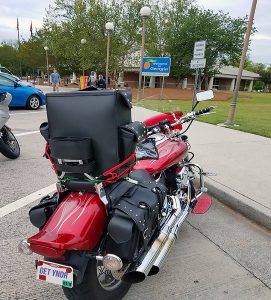 The highway can be intimidating, as things can change within a matter of minutes. Changes in weather, mechanical issues and fatigue are just a few of the things that should be planned for in advance. After all, our ultimate goal is to enjoy the ride and arrive safely. Here is a compiled list of tips and items to help better prepare you for your upcoming rides. These tips include suggestions on what you can do to prepare your body, things to pack, and mobile apps that maybe helpful.
The highway can be intimidating, as things can change within a matter of minutes. Changes in weather, mechanical issues and fatigue are just a few of the things that should be planned for in advance. After all, our ultimate goal is to enjoy the ride and arrive safely. Here is a compiled list of tips and items to help better prepare you for your upcoming rides. These tips include suggestions on what you can do to prepare your body, things to pack, and mobile apps that maybe helpful.
EXERCISE
Not many folks get much time to do this, but if you do, you will experience a significant difference in comfort levels, no matter the distance traveled.
- Squeeze Balls – for at least 30 minutes a day. You can do it at work, at home, in the car and while walking. Alternate hands every day.
- If you already have an exercise routine to build up muscle then stay with what you know, if not, consult an expert but the healthier your muscles and body are the more comfortable your ride will be.
NUTRITION
- About 6 to 8 weeks before a long-distance ride (along with your daily routine) be sure that you increase your intake on the following: water, protein, carbohydrates, calcium and potassium. Start to reduce your alcohol and caffeine intake.
- About 1 week before the ride increase on more water/ fluids and cut out all caffeine and alcohol.
- One day before the ride, do not eat anything that will cause you to have diarrhea or that may irritate your stomach or bowels. Eat at least one banana (or equal potassium supplement). Absolutely no caffeine or anything that stimulates alertness (you may need it during the ride and it won’t work if you didn’t detox before the ride).
- On the day you leave for your trip and each day while on the road, try to eat at least one or two bananas a day (one in the morning, one at night) if you can’t eat two, be sure to at least eat one.
- Increase salt intake (it will help you retain water so you don’t have to urinate as much).
- Drink fluids in small sips, but many times via your hydration pack throughout the actual “on the road” time. When you are stopped for the night (or day depending on when you prefer to ride) drink as much water/fluids as possible until you go to sleep. Please keep in mind that if riding through very hot climates, it may be best to do most of your seat time at night. When you wake up to get ready to hit the road, start sipping fluids and eat a breakfast high in protein, yet low in carbs. Increase your protein snacks at every gas stop and try to keep low in carbs but make sure you do eat some carbs. When you stop for the night, eat an appropriate size meal that contains a lot of carbs and protein.
WHAT TO PACK
This is a comprehensive list of suggestive items. Please keep in mind that the longer you ride, the heavier your bike may feel. Pack accordingly.
-
- Second bike key
- Emergency contact info either on you or in an obvious place on your person or with another rider riding with you (i.e. medical/road ID alert bracelet)
- Hard copy of the itinerary and put it in a zip lock bag and stored in a safe location
- Hydration Pack
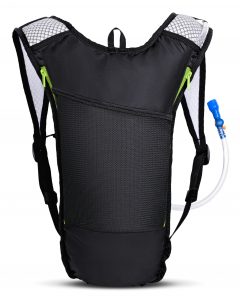
Hydration Pack - Octane Boost (for folks living on the East Coast who have bikes that are used to using 93 gasoline, then riding West, South or into Canada/Alaska, where the octane can range from 87 to 91, then you may need to carry this to help boost your octane levels up to what your bike is used to)
- Chapstick
- Wet wipes
- Clorox wipes
- Sunscreen
- Safety Kit
- Road flares
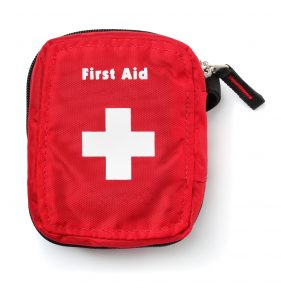
First Aid kit for minor injuries. - Flashlight
- Tire kit with plugs
- Fuses
- Air compressor for tires
- Portable battery charger
- Basic tool kits (depending on your bike)
- Heated gear (be sure you have tested it) / Freeze out
- Toe / Hand warmers
- Gum
- Ear plugs
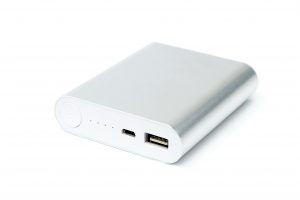
Portable Battery Charger - Chain lube
- Back up cell phone
- Stand‐alone GPS (separate from your main phone)
- Quarters for laundry
- Toiletries
- Zip lock bags/Space bags (varied sizes)
- Luggage bag (Waterproof if possible, if not then use Space bags/waterproof bags for clothes)
- Extra set of summer gloves
- Waterproof over gloves for heated gloves
- Clothes – limited, you can do laundry on the road (extra underwear and socks though)
- A comfortable pair of shoes to wear when not riding (if you get a room)
- Cash in case the gas station does not take credit cards or your credit cards don’t work
- Passport
- Special spot to put cash / emergency cards, copy of your license, registration, insurance cards and Passport just in case your wallet gets stolen or lost
- Bank Card/Credit card
- Sewing kit
- Lighter
- Zip ties – several varied sizes
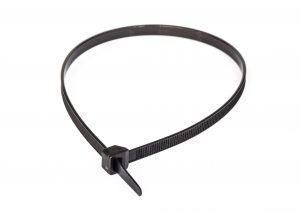
Single zip tie. - Duct tape
- Survival knife (but be aware that you can’t take any type of knives into Canada or Mexico)
- Pen and paper
- Microfiber cloths
- Rain X or something similar
- Extra Rok Straps / Bungee cords/nets in case the ones you are using get worn out on the trip (I recommend the adjustable Rok Straps 18” – 60”, the smaller ones can be useful as well but that is up to you)
- Mustard packets /pickles /pickle juice (helps with cramping)
- Plastic bags that can be used as boot liners when it rains
- Kickstand pucks
- Visine
- Umbrella (if you didn’t bring your camping equipment then you can use this to get some shade from the sun, especially useful if you break down on the road. It can protect you from the sun as well as the rain if you are waiting for assistance or trying to repair your bike.
After your list is completed, be sure to pack your motorcycle before you begin your journey and practice riding with the extra weight. It’s very important to make sure all your gears and gadgets work and feel comfortable. Do not buy brand new boots/gear right before the ride because it has not been broken in yet and you don’t know what it will do to your body or your ride so be sure that if you do buy new gear, you do it in enough time that you can use it well before the ride. There may be times while on the road that you do need new gear or accessories because it fails or gets lost on the road. Try to find that same type of item that matches what you are replacing. If you are in an area that doesn’t have what you need, try to order it online and have it shipped to a future destination. Most hotels will hold it for you if the reservation is in the name of the recipient.
RECOMMENDED APPS
Trackers – (if you are doing mountain riding or riding in areas that do not have a cell signal, I suggest the SPOT which is an actual device you can buy from any sporting goods store and it provides a yearly service subscription)
- Followmee
- Life 360
- Glympse

Spotwalla location tracker - Spotwalla
- RoadID
HOTEL APPS
- Priceline
- Hotels.com
WEATHER APPS
- Weather on Wheels
- Weather Radar
ROAD TRIP APPS
- Cost2Drive
- RV Parks & Campground
- USA Rest Stop Finder
- Fuel Finder Worldwide
- Toll
- AAA
GPS APPS
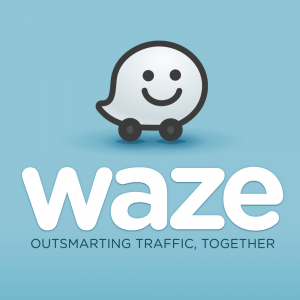
- Waze
- Google Maps
ADDITIONAL APPS AND WEBSITES
- Road ID https://www.roadid.com
- Get There Dry http://get‐there‐dry.com
- Gun Laws by State https://www.nraila.org/gun‐laws/state‐gun‐laws/
- State Map http://visitedstatesmap.com/
NOTIFICATIONS
Be sure you notify the following of your plans to travel:
- Bank
- Credit cards
- Family
- Job
- Close friends
See the complete article in our July/August issue. Written by: Kelly MzKelz Valdez


